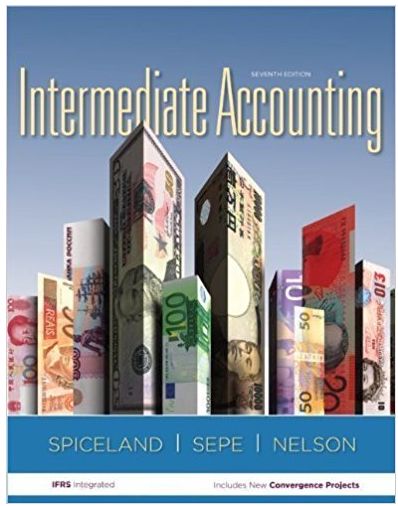The following questions are adapted from a variety of sources including questions developed by the AICPA Board
Question:
The following questions are adapted from a variety of sources including questions developed by the AICPA Board of Examiners and those used in the Kaplan CPA Review Course to study receivables while preparing for the CPA examination. Determine the response that best completes the statements or questions.
1. At January 1, 2013, Simpson Co. had a credit balance of $260,000 in its allowance for uncollectible accounts. Based on past experience, 2 percent of Simpson’s credit sales have been uncollectible. During 2013, Simpson wrote off $325,000 of accounts receivable. Credit sales for 2013 were $9,000,000. In its December 31, 2013, balance sheet, what amount should Simpson report as allowance for uncollectible accounts?
a. $115,000
b. $180,000
c. $245,000
d. $440,000
2. The balance in accounts receivable at the beginning of 2013 was $600. During 2013, $3,200 of credit sales were recorded. If the ending balance in accounts receivable was $500 and $200 in accounts receivable were written off during the year, the amount of cash collected from customers was
a. $3,100
b. $3,200
c. $3,300
d. $3,800
3. A company uses the allowance method to account for bad debts. What is the effect on each of the following accounts of the collection of an account previously written off?
Allowance for Uncollectible Bad DebtExpense
Accounts________________________________
a. Increase Decrease
b. No effect Decrease
c. Increase No effect
d. No effect No effect
4. The following information relates to Jay Co.’s accounts receivable for 2013:
Accounts receivable balance, 1/1/2013......... $650,000
Credit sales for 2013................ 2,700,000
Sales returns during 2013............... 75,000
Accounts receivable written off during 2013 ....... 40,000
Collections from customers during 2013......... 2,150,000
Allowance for uncollectible accounts balance, 12/31/2013.. 110,000
What amount should Jay report for accounts receivable, before allowances, at December 31, 2013?
a. $ 925,000
b. $1,085,000
c. $1,125,000
d. $1,200,000
5. Gar Co. factored its receivables without recourse with Ross Bank. Gar received cash as a result of this transaction, which is best described as a
a. Loan from Ross collateralized by Gar’s accounts receivable.
b. Loan from Ross to be repaid by the proceeds from Gar’s accounts receivables.
c. Sale of Gar’s accounts receivable to Ross, with the risk of uncollectible accounts transferred to Ross.
d. Sale of Gar’s accounts receivable to Ross, with the risk of uncollectible accounts retained by Gar.
6. The following information pertains to Tara Co.’s accounts receivable at December 31, 2013:
-1.png)
During 2013, Tara wrote off $7,000 in receivables and recovered $4,000 that had been written off in prior years. Tara’s December 31, 2012, allowance for uncollectible accounts was $22,000. Under the aging method, what amount of allowance for uncollectible accounts should Tara report at December 31, 2013?
a. $ 9,000
b. $10,000
c. $13,000
d. $19,000
7. West Company had the following account balances at December 31, 2013, before recording bad debt expense for the year:
Accounts receivable ...............$ 900,000
Allowance for uncollectible accounts (credit balance) ..16,000
Credit sales for 2013............... 1,750,000
West is considering the following methods of estimating bad debts for 2013:
• Based on 2% of credit sales
• Based on 5% of year-end accounts receivable
What amount should West charge to bad debt expense at the end of 2013 under each method?
-2.png)
Beginning in 2011, International Financial Reporting Standards are tested on the CPA exam along with U.S. GAAP. The following questions deal with the application of IFRS to accounting for cash and receivables.
8. Shaefer Company prepares its financial statements according to International Financial Reporting Standards (IFRS). Shaefer sometimes has bank overdrafts that are payable on demand and that fluctuate as part of its cash management program. At the most recent financial reporting date, Shaefer had a €500,000 overdraft in one cash account and a positive balance of €3,000,000 in another cash account. Shaefer should report its cash balances as:
a. A cash asset of €3,000,000 and an overdraft liability of €500,000.
b. A cash asset of €2,500,000.
c. An overdraft liability of (€2,500,000).
d. None of the above.
9. Under IFRS, accounts receivable can be accounted for as "available for sale" investments if that approach is elected upon initial recognition of the receivable under:
a. IASB No. 1.
b. IFRS No. 9.
c. IAS No. 39.
d. None of the above.
10. Under IFRS, measurement of an impairment of a receivable is required if:
a. Cash payments have not been received for more than twelve months.
b. It is at least more likely than not that a future loss will occur, and the amount of discounted loss is measurable.
c. It is reasonably possible that prior events will give rise to a future loss that can be estimated with moderate reliability.
d. There is objective evidence that a loss event has occurred that has an impact on the future cash flows to be collected and that can be estimatedreliably.
Financial statements are the standardized formats to present the financial information related to a business or an organization for its users. Financial statements contain the historical information as well as current period’s financial...
Step by Step Answer:

Intermediate accounting
ISBN: 978-0077647094
7th edition
Authors: J. David Spiceland, James Sepe, Mark Nelson





